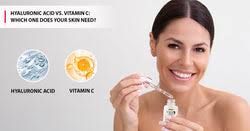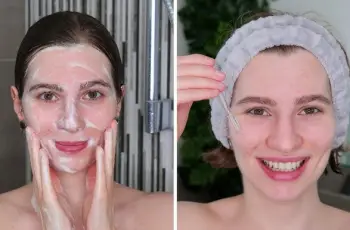
Understanding the Different Types of Hyaluronic Acid in Skincare
Hyaluronic acid has become a true skincare hero, celebrated for its ability to deeply hydrate, plump, and rejuvenate the skin across all ages and skin types.
From drugstore brands to luxury serums, it’s now a star ingredient featured in countless products—and with good reason.
But here’s the twist that many people don’t realize: not all hyaluronic acid is created equal, and the type used in your skincare really does matter.
There are actually different types of hyaluronic acid molecules, each varying in size, structure, and how deeply they can penetrate the skin.
In this article, we’ll break down the types of hyaluronic acid, explore how they work, compare their effects, and offer guidance on how to choose the right one for your skincare goals.
What Is Hyaluronic Acid and Why Is It Important for Skin Health?
Hyaluronic acid is a naturally occurring polysaccharide found in our skin, joints, and connective tissues, primarily responsible for retaining moisture and keeping everything lubricated.
It’s a humectant, meaning it attracts water from the environment and binds it to the skin, helping maintain hydration and improve overall skin texture.
What makes hyaluronic acid so impressive is its ability to hold up to 1,000 times its weight in water, offering unparalleled hydration that visibly plumps and smooths the skin.
Unfortunately, our natural hyaluronic acid production starts to decrease in our 20s, leading to dryness, fine lines, and a loss of youthful elasticity as we age.
That’s why applying hyaluronic acid topically has become such a powerful step in modern skincare routines—it replenishes what our skin loses over time.
Types of Hyaluronic Acid: A Breakdown by Molecular Weight and Structure
Most people don’t know that the term “hyaluronic acid” is an umbrella for several different forms of the ingredient, each offering a unique benefit based on its molecular size.
The molecular weight determines how deeply the ingredient can penetrate the skin—larger molecules stay closer to the surface, while smaller ones reach deeper layers.
Let’s look at the three most commonly used forms of hyaluronic acid in skincare products and see what each one brings to the table.
1. Hydrolyzed Hyaluronic Acid: The Surface Smoother
Hydrolyzed hyaluronic acid is produced by breaking down larger HA molecules into smaller fragments, allowing better absorption into the uppermost layers of the skin.
Because it doesn’t penetrate very deeply, hydrolyzed HA primarily hydrates the surface, giving your skin a temporarily plumped, refreshed, and smooth appearance.
It’s ideal for those looking to improve skin texture, reduce flakiness, or restore a dewy glow after cleansing or exfoliation.
Products with hydrolyzed HA are great for layering under makeup or for quick hydration boosts throughout the day.
Best for: Surface hydration, smoothing, and gentle moisture for dry, flaky, or environmentally stressed skin.
2. Sodium Hyaluronate: The Deep Hydrator
Sodium hyaluronate is the salt form of hyaluronic acid and is known for having a smaller molecular size, which allows it to penetrate deeper into the layers of the skin.
This version is more chemically stable, less prone to oxidation, and more compatible with a variety of skincare formulations and pH levels.
It doesn’t just hydrate—it also supports elasticity, reduces the appearance of fine lines, and helps improve skin density over time.
However, using too much sodium hyaluronate (especially above 4% concentration) can sometimes lead to trans-epidermal water loss in dry climates, reversing its benefits.
Best for: Deep hydration, reducing wrinkles, long-term skin improvement, and those concerned with aging or chronic dehydration.
3. Sodium Acetylated Hyaluronate: The Long-Lasting Shield
This modified version of sodium hyaluronate includes acetyl groups, which enhance its ability to cling to the skin and provide extended hydration throughout the day.
It not only hydrates but also forms a lightweight barrier that helps protect the skin against moisture loss and environmental stressors.
It’s especially helpful for people with damaged skin barriers, chronic dryness, or anyone looking for all-day hydration from a single application.
Its film-forming property makes it ideal for those in dry, windy, or cold climates where hydration loss is constant and difficult to manage.
Best for: Long-lasting hydration, barrier support, and protecting sensitive or irritated skin from external aggressors.
Why Molecular Weight Matters in Hyaluronic Acid
The molecular weight of hyaluronic acid affects how deep it can go and how long its effects will last—so it’s worth paying attention to this detail when buying products.
High molecular weight HA stays on the surface and gives immediate plumping; low molecular weight HA goes deeper for sustained hydration and collagen support.
Many advanced products now use multi-molecular formulations, combining various types of HA to hydrate multiple layers of the skin simultaneously.
This layered approach means you get both instant results and long-term benefits—making the most of what hyaluronic acid can offer.
If you see terms like “multi-weight HA” or “cross-linked HA” on your product, you’re likely getting a blend that delivers superior performance.
How to Choose the Right Type for Your Skin Needs
If you have dry or sensitive skin, focus on surface hydration with hydrolyzed HA or sodium acetylated hyaluronate for gentle, non-irritating moisture throughout the day.
For mature, aging, or sun-damaged skin, opt for sodium hyaluronate, which penetrates deeper and can help plump fine lines and improve elasticity over time.
If your skin type is normal or combination, a serum containing multiple forms of HA will give you balanced hydration without overwhelming your skin.
Also, be cautious of climate—HA needs water in the environment to pull into your skin, so in dry conditions, always apply it on damp skin and seal it with moisturizer.
Look for added ingredients like glycerin, panthenol, or ceramides in your HA products to further enhance hydration and support the skin’s natural barrier.
How Much Hyaluronic Acid Should Be in Your Product?
More isn’t always better—when it comes to HA, the sweet spot for effectiveness in skincare lies between 0.1% and 2%, depending on the formulation.
Some products boast “90% hyaluronic acid,” but this usually refers to a diluted base solution rather than the actual active concentration of the ingredient.
Excessive HA, especially in dry environments or without a moisturizer, can backfire and cause dehydration instead of hydration due to moisture being pulled from your skin.
Stick to trusted formulations that balance concentration with supporting ingredients that enhance hydration without risking water loss.
For beginners, a 1% HA serum layered under a moisturizer is a great starting point for safe, noticeable results.
How to Use Hyaluronic Acid Correctly in Your Routine
Always apply HA to clean, slightly damp skin—this helps it attract water effectively and maximizes hydration at the time of application.
Follow immediately with a rich moisturizer, balm, or face oil to seal in the hydration and prevent it from evaporating into dry air.
Here’s the ideal step-by-step routine:
Cleanse your skin with a gentle cleanser.
Mist or tone with water or a hydrating toner.
Apply your HA serum to damp skin using upward motions.
Seal it in with a moisturizer or oil rich in barrier-supporting ingredients.
Finish with SPF in the morning to protect your hydrated skin from UV damage.
At What Age Should You Start Using Hyaluronic Acid?
There’s no wrong age to begin using HA—it’s suitable for all skin types and ages because it naturally mimics what your skin already produces.
In your 20s, HA can help maintain hydration and delay the onset of fine lines from early environmental damage.
In your 30s and 40s, HA can address moisture loss and support the skin as it begins to lose elasticity and collagen.
In your 50s and beyond, it helps soften deeper wrinkles, improve firmness, and replenish moisture lost due to hormonal shifts and aging.
Think of HA not just as an anti-aging tool, but as a long-term investment in the health and comfort of your skin.
When to See a Dermatologist About Hydration Concerns
If you’ve tried multiple HA products and still feel dry or irritated, it may be time to consult a dermatologist to rule out underlying conditions like eczema or barrier damage.
You might benefit more from a prescription-strength humectant, an occlusive ointment, or a barrier repair treatment that goes beyond topical HA.
Also, if you’re introducing a new HA product, always patch test first—apply a small amount to your wrist or behind the ear and monitor for reactions over 24 hours.
This helps prevent irritation or allergic response, especially with products that contain active blends or high concentrations of other ingredients.
Your dermatologist can also recommend professional-strength treatments, like injectable HA fillers or HA-rich facials, for more dramatic results.
Final Thoughts: The Power of Knowing Your HA Types
Hyaluronic acid is absolutely worth the hype—but understanding the difference between its various forms is what turns good skincare into great skincare.
Each type has a specific role, and when used together or thoughtfully selected, they can deeply hydrate, protect, and rejuvenate your skin for visible, lasting improvements.
Look for products that mention “multi-molecular hyaluronic acid” or blends that include sodium hyaluronate and sodium acetylated hyaluronate for a complete approach.
Use your HA serum on damp skin, follow with a sealing moisturizer, and adjust your routine based on your skin’s needs and your local environment.
With the right formulation and method of application, hyaluronic acid can be one of the most valuable and effective ingredients in your skincare arsenal.


